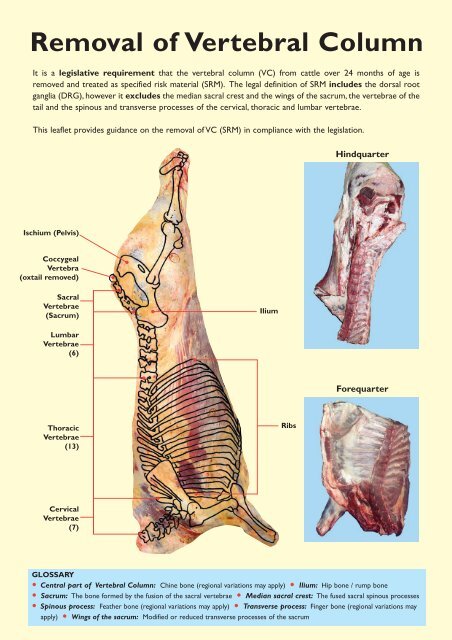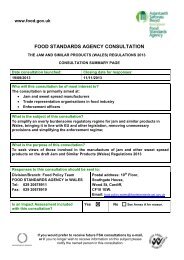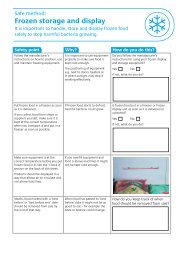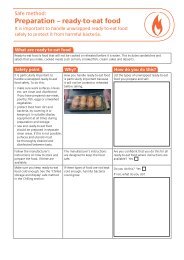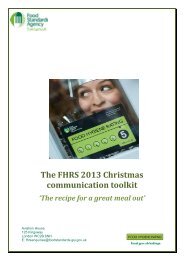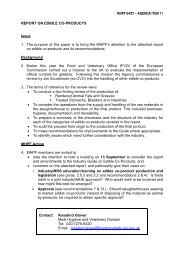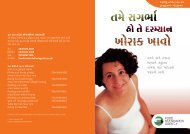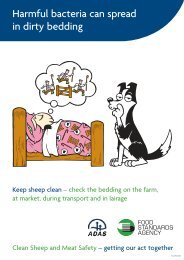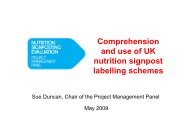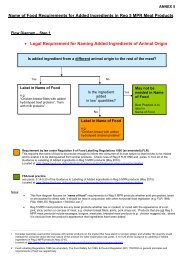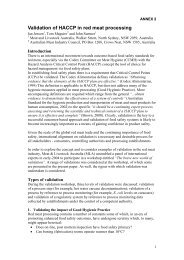745 Removal of Vertebral Column - Food Standards Agency
745 Removal of Vertebral Column - Food Standards Agency
745 Removal of Vertebral Column - Food Standards Agency
Create successful ePaper yourself
Turn your PDF publications into a flip-book with our unique Google optimized e-Paper software.
<strong>Removal</strong> <strong>of</strong> <strong>Vertebral</strong> <strong>Column</strong><br />
It is a legislative requirement that the vertebral column (VC) from cattle over 24 months <strong>of</strong> age is<br />
removed and treated as specified risk material (SRM). The legal definition <strong>of</strong> SRM includes the dorsal root<br />
ganglia (DRG), however it excludes the median sacral crest and the wings <strong>of</strong> the sacrum, the vertebrae <strong>of</strong> the<br />
tail and the spinous and transverse processes <strong>of</strong> the cervical, thoracic and lumbar vertebrae.<br />
This leaflet provides guidance on the removal <strong>of</strong> VC (SRM) in compliance with the legislation.<br />
Hindquarter<br />
Ischium (Pelvis)<br />
Coccygeal<br />
Vertebra<br />
(oxtail removed)<br />
Sacral<br />
Vertebrae<br />
(Sacrum)<br />
Ilium<br />
Lumbar<br />
Vertebrae<br />
(6)<br />
Forequarter<br />
Thoracic<br />
Vertebrae<br />
(13)<br />
Ribs<br />
Cervical<br />
Vertebrae<br />
(7)<br />
GLOSSARY<br />
• Central part <strong>of</strong> <strong>Vertebral</strong> <strong>Column</strong>: Chine bone (regional variations may apply) • Ilium: Hip bone / rump bone<br />
• Sacrum: The bone formed by the fusion <strong>of</strong> the sacral vertebrae • Median sacral crest: The fused sacral spinous processes<br />
• Spinous process: Feather bone (regional variations may apply) • Transverse process: Finger bone (regional variations may<br />
apply) • Wings <strong>of</strong> the sacrum: Modified or reduced transverse processes <strong>of</strong> the sacrum
STEP-BY-STEP GUIDE TO REMOVAL OF<br />
VERTEBRAL COLUMN FROM PRIMAL CUTS<br />
Sacral vertebrae (including the median sacral crest and wings <strong>of</strong> the sacrum) : Rump<br />
Median sacral crest<br />
Median sacral crest<br />
Wing <strong>of</strong> sacrum<br />
The wing <strong>of</strong> the sacrum is out <strong>of</strong> view on underside <strong>of</strong> meat<br />
Rump showing median sacral crest. Dotted line<br />
indicates portion <strong>of</strong> the sacral crest that could be<br />
left attached to the primal rump.<br />
Lumbar vertebrae : Sirloin<br />
Rump with wing <strong>of</strong> sacrum partially separated by<br />
knife, leaving the ilium attached to the rump.<br />
Dotted line indicates portion <strong>of</strong> the wing that could<br />
be left attached to the primal rump.<br />
SRM<br />
Sacrum removed as one piece including the median<br />
sacral crest and the wing <strong>of</strong> the sacrum.<br />
Spinous Process<br />
Transverse Process<br />
SRM<br />
Bone-in sirloin.<br />
Partial separation <strong>of</strong> the vertebrae from the sirloin<br />
with the transverse and spinous processes remaining<br />
attached.<br />
Vertebrae removed and left untrimmed.
Thoracic vertebrae : Forerib (also applies to the chuck)<br />
Rib<br />
Cutting<br />
point<br />
Spinous Process<br />
Transverse Process<br />
Cutting point<br />
SRM<br />
Bone-in forerib.<br />
Partial separation <strong>of</strong> the vertebrae with the ribs and<br />
spinous processes remaining attached to the meat.<br />
Vertebrae removed and left untrimmed.<br />
Cervical Vertebrae : Neck<br />
Transverse Processes<br />
Spinous Processes<br />
SRM<br />
Vertebrae<br />
Atlas<br />
Spinous Process out <strong>of</strong> view on underside <strong>of</strong> meat<br />
Posterior end <strong>of</strong> neck showing the vertebral<br />
structure (cut through at the 6th cervical vertebra).<br />
Axis<br />
Anterior end <strong>of</strong> neck showing the first two<br />
vertebrae (the atlas and axis).<br />
<strong>Removal</strong> <strong>of</strong> the vertebrae left untrimmed.<br />
Although the spinous and transverse processes are<br />
not SRM they are removed with the vertebrae to<br />
avoid leaving DRG attached in the meat.<br />
If you have any queries about this leaflet please contact your local authority.<br />
(c) <strong>Food</strong> <strong>Standards</strong> <strong>Agency</strong> 2006<br />
Prepared by the <strong>Food</strong> <strong>Standards</strong> <strong>Agency</strong> in conjunction with the Meat and Livestock Commission.
Dorsal Root Ganglia (DRG)<br />
Handling Specified Risk Material<br />
Courtesy: University <strong>of</strong> Bristol<br />
The spinal cord lies in the spinal or vertebral canal<br />
within the vertebral column. A number <strong>of</strong> nerves arise<br />
from the spinal cord and each nerve exits the canal via<br />
a foramen (the space between adjacent vertebrae). As<br />
the nerves exit the canal they form the Dorsal Root<br />
Ganglia (DRG). The exact location <strong>of</strong> the DRG can vary<br />
along the length <strong>of</strong> the vertebral column and they can be<br />
found inside or outside a foramen (the latter is shown<br />
in the illustration above).<br />
The DRG are defined as SRM and the butchery<br />
procedures illustrated in this guide have been designed<br />
to avoid DRG remaining in the meat after boning.<br />
Thoracic vertebra with rib<br />
Spinal /<br />
vertebral<br />
canal<br />
Rib<br />
Spinous Process<br />
Transverse Process<br />
The ribs are not defined as SRM but the cutting lines<br />
indicated have been selected to avoid leaving DRG in<br />
the meat.<br />
Boning methods and practices which avoid SRM<br />
remaining in the meat<br />
Traditional boning practice, which aims to maximise<br />
yield by removal <strong>of</strong> bones cleanly and individually,<br />
increases the likelihood that DRG will remain with the<br />
meat. Sheet boning, where bones are removed in one<br />
piece without further trimming, reduces this likelihood.<br />
Also, removing the fillet by pulling it out as opposed to<br />
cutting it out will reduce the potential for the DRG to<br />
remain within the meat.<br />
Simple equipment for storage and staining <strong>of</strong> specified risk material<br />
can be purchased from any DIY or hardware store.<br />
Bins must be:<br />
• Labelled (i) "SRM" and (ii) "Cat. 1 ABP.<br />
For disposal only".<br />
• Impervious (leakpro<strong>of</strong>) and covered.<br />
• Kept adequately separate from any food.<br />
• Thoroughly washed as soon as reasonably<br />
practical after use.<br />
• If intended for any use other than SRM, they<br />
must be thoroughly washed and disinfected<br />
before such use.<br />
Staining means treating the material (by immersion,<br />
spraying or other application) with a 0.5% weight/<br />
volume solution <strong>of</strong> the colouring agent Patent Blue V<br />
(E131, 1971 Colour Index No. 42051). The stain must<br />
be applied in such a way that the colouring is and<br />
remains clearly visible over the whole surface <strong>of</strong> the<br />
material.<br />
A Commercial Document (CD) must be<br />
completed and accompany the SRM despatched for<br />
disposal. A copy <strong>of</strong> the CD must be retained for two<br />
years.


